Pavement and Highways Testing
Transport projects tend to make up a high proportion of government infrastructure spending, with road schemes consuming a significant amount of this capital expenditure. New plans, such as the UK £15 billon ‘Road investment strategy’ announced in 2014 (GOV.UK, 2014), ensure this trend will continue into the future, with considerable investigation and design expertise being therefore required from civil engineering practice.

When designing new roads and highways, understanding and quantifying the performance of different unbound base and sub-base materials is of key importance. Here the resilient modulus and permanent deformation tests, carried out in the laboratory using a dynamic triaxial apparatus, provide such information, enabling engineers to rank various materials and calculate the structural response of pavements. With this testing requirement in mind, GDS have developed two configurable dynamic triaxial systems designed specifically for resilient modulus and permanent deformation testing. These systems, using either an electro-mechanical or hydraulic loading actuator, can be specified by the user to meet the test standard of their choice (e.g., AASHTO T-307, AS 1289.6.8.1 etc.), with all configurations automated via GDSLab and its Resilient Modulus test module.

Test Standards for Pavement & Highways
AASHTO T-307-99
| Standard method of test for determining the resilient modulus of soils and aggregate materials. These parameters are integral for quantifying the performance of different unbound base and sub-base materials, enabling engineers to rank various materials and calculate the structural response of pavements. |
AG:PT/T053
| Determination of permanent deformation and resilient modulus characteristics of unbound granular materials under drained conditions. These parameters are integral for quantifying the performance of different unbound base and sub-base materials, enabling engineers to rank various materials and calculate the structural response of pavements.
|
AS 1289.6.8.1
| Determination of the resilient modulus and permanent deformation of granular unbound pavement materials. These parameters are integral for quantifying the performance of different unbound base and sub-base materials, enabling engineers to rank various materials and calculate the structural response of pavements.
|
Products for Pavement & Highways
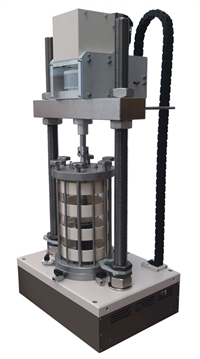
| Resilient Modulus Testing System (RMTS)
The GDS Resilient Modulus Testing System (RMTS) enables the resilient modulus and permanent deformation of unbound base/sub-base pavement materials to be determined. The system, based around the GDS ELDYN, uses an axially-stiff load frame with a beam mounted electro-mechanical actuator to apply dynamic cyclic axial loads, with a GDS triaxial cell used to confine the test specimen. |
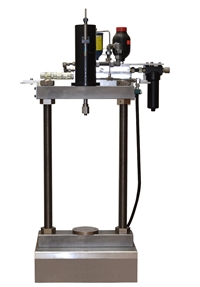
| Hydraulic Resilient Modulus Testing System (HRMTS)
The GDS Hydraulic Resilient Modulus Testing System (HRMTS) enables the resilient modulus and permanent deformation of unbound base/sub-base pavement materials to be determined. The system, based around the GDS ELDYN, uses an axially-stiff load frame with a beam mounted hydraulic actuator to apply dynamic cyclic axial loads, with a GDS triaxial cell used to confine the test specimen. |
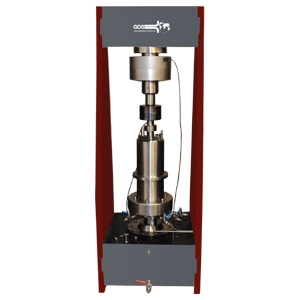
| ST-RTS - Static Triaxial Rock Testing System
The Static Triaxial Rock Testing System enables axial load application up to 1MN, with triaxial cellsrated up to 70MPa used to confine test specimens of maximum 50mm diameter. |
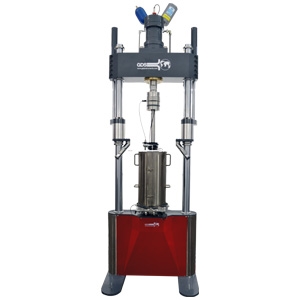
| DT-RTS - Dynamic Triaxial Rock Testing System
The Dynamic Triaxial Rock Testing System can apply axial loads of up to 400kN at dynamic frequencies of 20Hz and below. Dynamic loading is achieved using a servo-hydraulic actuator system. |
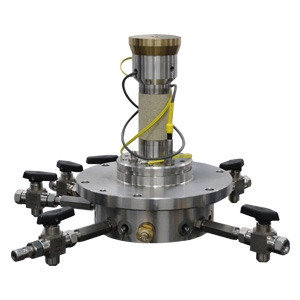
|
Acoustic Velocity (GDSAV) transducers measure the P- and S- wave velocities within a test specimen. Sensors and sources can be mounted in either the pedestal and top-cap, or both sides of the specimen in some cases, enabling acoustic velocities to be measured in multiple directions. Such small-strain information is often required when designing and constructing new underground spaces. |
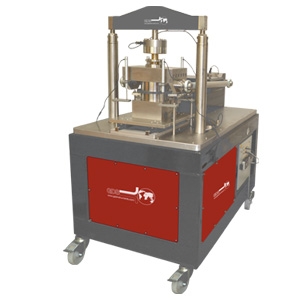
| GDSLADS - Large Automated Direct Shear (300mm)
The Large Automated Direct Shear system is an electro-mechanical direct shear testing device for specimens of up to 300mm square in size. |
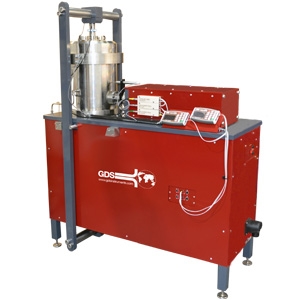
| HPBPS - Back Pressure Shearbox - High Pressure
The High Pressure Back Pressure Shearbox is a high pressure version of the GDSBPS. Normal and shear loads of up to 100kN may be applied to the test specimen, with a back pressure of up to 10MPa available. |
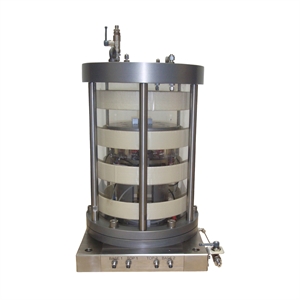
| GDS Resonant Column Apparatus For many years the resonant column apparatus has been used in research and commercial laboratories to estimate values of the shear modulus, G, and damping ratio, D, for soil specimens across the small to medium strain range (< 1 %).
The variation in these parameters with increasing strain magnitude allows engineers to conduct dynamic response analyses, such as those using finite element and non-linear analytical methods, which enable performance assessment of natural and engineered structures subjected to dynamic and cyclic loadings.
|
Product Applications